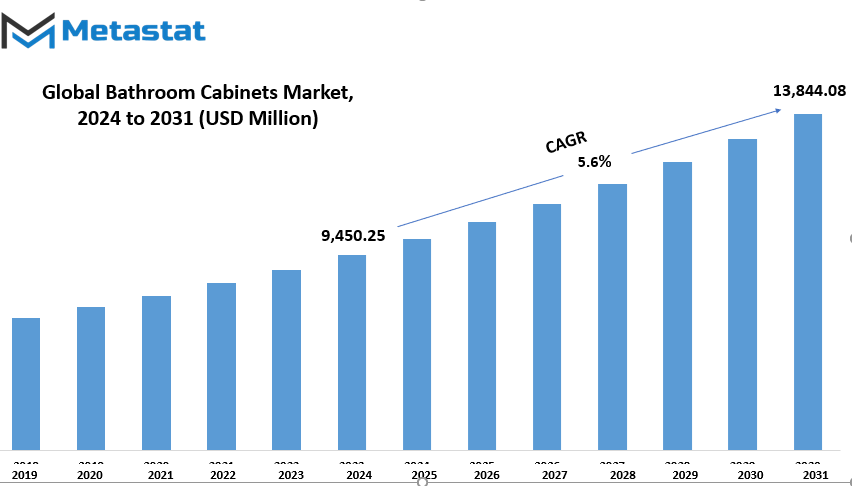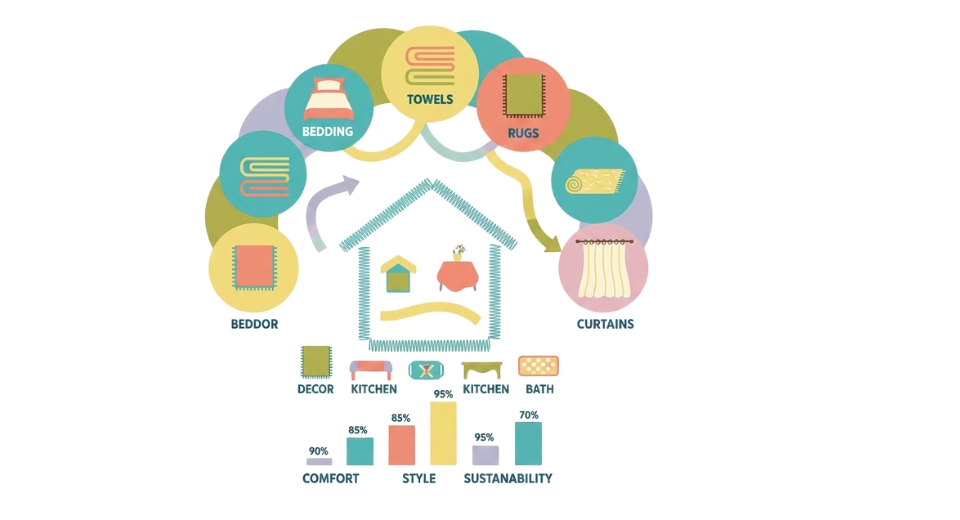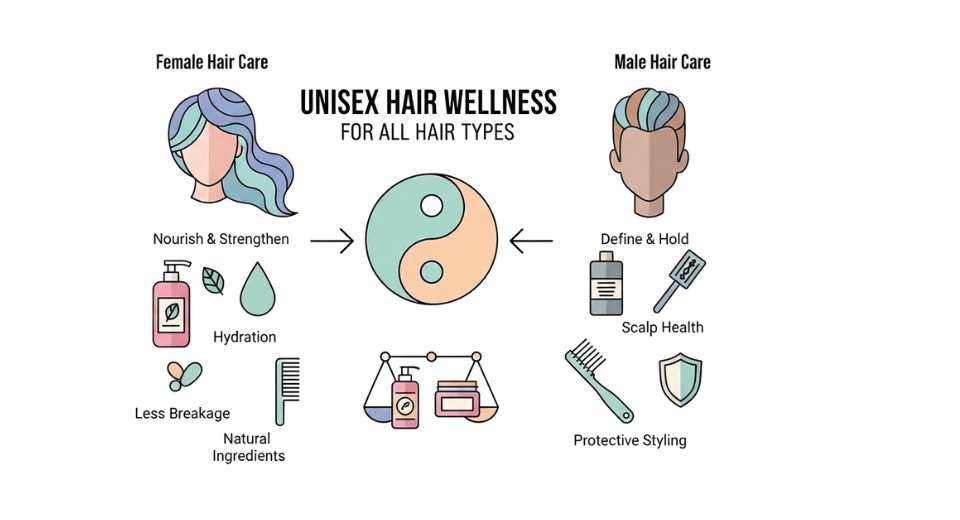MARKET OVERVIEW
The Global Bathroom Cabinets market is a dynamic segment of the home improvement industry that is going to see transformative changes in the near future as well. The changing preferences of consumers will also lead to increased demand for innovative and functional bathroom storage solutions. Such a market would not only provide the traditional cabinetry but also feature smart and space-saving designs to meet modern needs in bathrooms. Future trends of bathroom cabinets would most likely be based on convenience, aesthetics, and sustainability, something that would appeal to the homeowners all over the different regions.
Within the next coming years, modern technology will probably be integrated in the design and functionality of the bathroom cabinets. With smart homes becoming more mainstream, bathroom cabinets would probably incorporate built-in sensors, lighting, and storage management systems that can optimize space for a better experience for the users. Homeowners will be able to control their bathroom storage with voice commands or smartphone applications, ushering in a new era of convenience in personal spaces. This will be especially relevant in small or compact bathrooms, where maximizing storage while maintaining a clean and sleek look will become even more essential.
Sustainability is likely to be the center of the future Global Bathroom Cabinets market. Environmental issues are likely to be on top, and there will be an increase in demand for ecological materials and responsible production methods. Probably, the manufacturers will use sustainable woods, recycled materials, and non-toxic finishes to ensure that the bathroom cabinets they offer are in compliance with consumer demand to maintain an environmentally friendly choice. This shift will not only help reduce the ecological footprint of bathroom cabinetry but will also allow manufacturers to become more compliant with the stricter regulations set on sourcing materials and waste management.
From a design standpoint, minimalism is going to be the direction of the market. As bathrooms increasingly become a space for retreat, people are looking for a clean, streamlined look. Cabinets will be one of the high-demand items because they seamlessly blend with other elements within the bathroom while providing both style and functionality without overwhelming the space. Customization will also take precedence, whereby consumers will get a wide array of sizes, finishes, and features to cater to their specific preferences and layouts in the bathrooms.
The online shopping and digital platforms will continue to change the landscape of the Global Bathroom Cabinets market. E-commerce will provide consumers with a wider variety of options, from traditional designs to more modern, innovative solutions. Virtual reality (VR) tools might become a key feature in bathroom cabinet shopping, allowing customers to visualize how different designs will look in their bathrooms before making a purchase. This will affect purchasing behavior and create a much more engaging, immersive experience by giving people easy access to more information and even allowing them to preview the products in a virtual space.
When the market matures, demand for superior quality craftsmanship and material durability will be at its highest. Consumers will start demanding bathroom cabinets that satisfy not only aesthetic appeal but also pass the test of time with durability and performance. Such a demand shift will come with a quest for long-term investment, not just in terms of style but in terms of usability as well.
In conclusion, further evolution of the Global Bathroom Cabinets market will be dictated by technology, sustainability, and customization. Thus, manufacturers are going to adapt to consumer needs, which continue to shift more toward innovative designs that are conscious of the environment and functional for the user. This will ensure a more adaptable and accessible bathroom cabinetry market with a greater variety of options that meet new needs and preferences of homeowners from around the globe.
Global Bathroom Cabinets market is estimated to reach $13,844.08 Million by 2031; growing at a CAGR of 5.6% from 2024 to 2031.

GROWTH FACTORS
The steady growth of the global bathroom cabinets market is a result of a few key drivers. The primary driver for this rise is increasing demand for optimizing space in modern bathrooms. The trend among people nowadays is to use their space effectively and make the most of their available space, hence the requirement for efficient and well-designed storage solutions. Bathroom cabinets are, therefore, responsible for organizing the bathroom essentials with a touch to the overall décor of the area. As customers continue to embrace the trend to maximize bathroom space, consumers also seek cabinets that make both aesthetic sense and are purposeful.
Other factors driving market growth for bathroom cabinets include greater focus on aesthetic appeal in bathroom design. As a result of a growing trend for home renovation, consumers are making more emphasis on the design and look of their bathrooms. For this reason, homeowners are finding products that both solve practical purposes as well as the aesthetic appeal for their bathrooms. This has made the demand for bathroom cabinets grow as they serve both purposes-design appeal and storage. This way, bathroom cabinets are considered must-haves during home renovation activities, which thus boosts their sale in the market.
Despite these positive trends, market growth is stymied by the following challenges. Although costly, premium bathroom cabinets remain a significant concern amid budget-sensitive markets, as consumers may find it difficult to justify such an expense. A high-end cabinet would, after all, have more luxury finishes and advanced features than its more affordable counterparts, but the price may become a burden in itself. A small bathroom has fewer storage space options, resulting in a larger cabinet size that may not be feasible to use, thereby discouraging some consumers from adopting the product in this market.
On the flip side, some positive growth avenues have been presented and would contribute in getting the industry ahead. Among such growth areas includes increased interest among consumers concerning their need to achieve greenery or sustainability. A number of bathroom furniture seekers who will aim to buy sustainable, environment-friendly materials will lead them towards purchasing environmentally-friendly bathroom cabinets. This trend towards sustainability will most probably open up some lucrative opportunities for manufacturers to cater to this growing market segment in the coming years.
In the global bathroom cabinets market, it is the demand for optimization of space and increased focus on aesthetic appeal in the design of the bathroom that has been the driver. High cost and space may be constraints for growth in specific areas; however, growing demand for sustainable products presents great potential for the future.
MARKET SEGMENTATION
By Type
The global market for bathroom cabinets is diversified. There are several types of cabinets that cater to various needs and preferences. Among those, single door cabinets hold the most significant share, generating revenue of $1,048.40 million. These cabinets are popular because they are compact and practical, hence ideal for small bathrooms or for simple storage solutions in case one wants a simple way of storing. Double door cabinets have more storage space, and it is usually chosen by those who require more space for the organization of bathroom essentials.
Multi-door cabinets have multiple doors and provide more storage capacity. It is often used in bigger bathrooms or households that have several members requiring more storage space. Mirrored cabinets are another popular variant, which unites the cabinet's functionality with an added benefit: a mirror. Such a cabinet is preferred by those who wish to save space and have a convenient place for storing toiletries while using the mirror for their daily grooming needs.
Wall-mounted cabinets are mounted on the wall. They save floor space and provide a modern look. They are ideal for small bathrooms where the floor space is limited, and they provide a modern look to the bathroom. Floor-standing cabinets are mounted on the floor. These cabinets have more storage capacity than the wall-mounted cabinets. They are often picked for large bathrooms or by someone who prefers more of a classic look and feel, with large space for putting things.
All types of bathroom cabinets have specific advantages, dependent on the kind of needs in the user, as well as the available area in the bathroom. These cabinets continue to grow in demand because people are searching for practical and stylish storage solutions for their bathrooms. The variety within the market continues to change as bathroom designs evolve, thus offering options for any user looking for saving space in small bathrooms or a larger storage cabinet in more luxurious bathrooms.
By Material Type
The bathroom cabinets market is segmented into various material types: wood, metal, glass, and plastic. Each of these materials has its own set of advantages that affect the development and demand of the market.
Wooden bathroom cabinets are some of the most demanded items for people to buy. Wood is considered to be naturally beautiful and warm, making it great material when trying to create a cozy and traditional look. Also, it is really durable and can withstand the wear and tear of time. The applications of wood are quite versatile and easy to customize according to various different finishes, such as varnishes or paints, in order to suit each type of bathroom style.Wooden cabinets are also considered to be an ageless selection that can give value to a house. These cabinets come in various styles, from a more rustic appearance to sleek and modern, and therefore can complement most bathroom themes.
Metal bathroom cabinets are made with a sleek, modern design. Metal is very durable, resistant to water damage, rust, and corrosion. These properties make metal an ideal choice for bathroom usage, since bathrooms are mostly wet places. These types of cabinets are most commonly found in modern bathroom designs and can be seen in several finishes: stainless steel, chrome, or aluminum. A very clean and shiny appearance is provided by metal cabinets to those wanting a more minimalist or industrial look. While metal cabinets lack the warmth that wood would give, they compensate with strength and long-term performance.
Glass bathroom cabinets are ideal for the generation looking to make the bathroom more open and airy. Glass is frequently applied as a cabinet door or shelves whereby one can view what is inside with much ease. They are more suitable in decoration or for the essentials of the bathroom, creating an organized and refined view in the bathroom. Glass cabinets can sometimes be supported by metal or wooden frame cabinets, where the appeal of glass can be merged with other material's strength. Nonetheless, glass cabinets are high-maintenance items, as they require frequent cleaning for their glass appearance. Thus, this type of cabinet may not be ideal for high-traffic bathroom designs because glass does break easily.
Plastic bathroom cabinets can sometimes be very affordable and easy to use. Plastic is a light, water-resistant material that is low maintenance. These cabinets are often found to be ideal for budget-friendly bathroom renovations or those where durability is the major concern. Plastic cabinets are widely available in a kaleidoscope of colors and styles for a wide range of bathroom themes, but a plastic cabinet does not command even a fraction of the elegance that one would achieve with a wooden or glass cabinet.
Put in a few words, the world bathroom cabinet market differs through usage of wood, metal, glass, and plastic materials. With different unique properties for every single material, which fulfills needs, tastes, and budget conditions, a variety of bathrooms offers perfect solutions.
By Distribution Channel
The market for bathroom cabinets has significantly increased, and is impacted by factors such as the desire for home improvement and remodeling. The above trend has, therefore, led to an increase in demand for bathroom cabinets on a global scale in terms of functionality and aesthetics. Specifically, distribution channels are also one of the ways through which this market has been categorized with online and offline segments.
Over the years, online distribution channels have gained considerable momentum. This is mainly because of the convenience and ease of shopping online, which has made it increasingly popular among consumers. The people can sit in their bedrooms and browse around a wide variety of bathroom cabinets, compare the prices, and read reviews to make the proper choice. In addition, the online stores also offer more than the normal brick-and-mortar stores offer and thus help the consumer in selecting more products before buying. Another factor that attracts people to buy online is being able to order products directly for delivery to their house.
Offline retailing channels still form a significant chunk of the distribution channel. Customers prefer to visit physical stores due to the added advantage of inspecting and checking the product. This is a very important experience when buying, for example, bathroom cabinets: quality and proper fit are top priorities. Besides, in-store shopping provides the customer with a chance to contact the salesmen to clear some inquiry over the respective product and to get proper consultation services from experts. Thus, that is very convenient for most consumers who prefer not standing in line for goods delivery in case goods are ordered via the Internet.
Online and offline have disparate merits that meet the needs of other consumer groups. Some customers would prefer shopping online because of its ease and options, while others would still opt for the human touch and immediacy that comes with a physical store. Consequently, the bathroom cabinet market keeps changing, and businesses do their best to keep up with consumers' needs by using both online and offline channels. These distribution channels play a very important role in ensuring that customers get access to the products they want in the most convenient way possible.
By End-Users
The Bathroom Cabinets market globally is a two-tier segmented market based on end-users: Residential and Commercial. These two have dominated the growth and demands in the market place of bathroom cabinets worldwide.
Residential refers to bathroom cabinets in private homes. This will include apartments, with different sizes going up to the biggest houses in towns. Increased demand in residential sectors for bathroom cabinets has witnessed growth due to the increased want to enhance the look, functionality, and storage of a house. The need to spend more time within one's home has led people into investing in making spaces comfortable and practical. Boom in renovation of houses has also accompanied an increase in demand for bathroom cabinets.
Consumers seek stylish and space-efficient options for storing toiletries, towels, and other bathroom essentials. Manufacturers have been responding with a wide variety of styles, finishes, and sizes to suit different customer preferences as bathroom interior design is becoming more prominent. The residential segment is likely to continue to grow as homeowners are increasingly interested in bathroom organization and design.
The commercial segment consists of bathroom cabinets used in public and business spaces. These include hotels, office buildings, shopping malls, hospitals, and other commercial establishments. Commercial bathrooms usually demand a different approach, emphasizing durability, practicality, and high-volume usage. Businesses seek cabinets that can withstand heavy use while maintaining a clean and professional appearance.
The commercial market also includes specialized cabinets designed for larger spaces and public areas, offering features such as easy cleaning and storage efficiency. As businesses and institutions continue to invest in modernizing their facilities, the demand for commercial bathroom cabinets will continue to rise.
The residential and commercial sectors will both drive the overall growth of the global Bathroom Cabinets market. The interest in home improvement and the modernization of commercial facilities will continue to influence market trends. The manufacturers will have to accommodate both segments as consumers' needs keep changing and businesses focus on giving better amenities. This market shall very likely witness innovations in design, materials, and functionality to cater to diversified end-users.
|
Report Coverage |
Details |
|
Forecast Period |
2024-2031 |
|
Market Size in 2024 |
$9,450.25 million |
|
Market Size by 2031 |
$13,844.08 Million |
|
Growth Rate from 2024 to 2031 |
5.6% |
|
Base Year |
2022 |
|
Regions Covered |
North America, Europe, Asia-Pacific Green, South America, Middle East & Africa |
REGIONAL ANALYSIS
The global market of bathroom cabinets can be divided into several geographic regions, each showing unique characteristics and demand patterns. This segmentation helps in the understanding of regional trends and business opportunities in the industry of bathroom cabinets.
The market has been further divided in the U.S., Canada, and Mexico. The United States is a very significant player where the demand is high for both modern and traditional bathroom cabinetry. Canada, although smaller in size, is showing a rising interest in green and space-saving designs, as is the trend for sustainability. Mexico is seeing a growing demand for affordable yet stylish bathroom cabinets, driven by the growing middle class and the construction sector.
Europe is another key market, further broken down into the UK, Germany, France, Italy, and the Rest of Europe. Functional, yet aesthetically pleasing, cabinets are what the UK seems to prefer. In Germany, demand is quite high for premium-quality cabinets that last a long time and often with the most sophisticated storage systems. France and Italy, which are renowned for their design prowess, have the greatest influence on this market, and luxurious and artistic cabinet styles are their specialities. The rest of Europe shows a mix of preferences, with a rising interest in innovative storage solutions and smart technology integration.
The market comprises India, China, Japan, South Korea, and the Rest of Asia-Pacific. China is the largest market in the region and shows strong demand for both affordable and premium bathroom cabinets. The market is growing due to rapid urbanization and increased spending on home improvement. The countries of Japan and South Korea, which are highly advanced in terms of technology, prefer smart bathroom cabinets with features such as integrated lighting and touchless controls. In India, the market is growing with a focus on cost-effective, space-efficient designs suited to smaller living spaces.
Demand in the bathroom cabinet segment in South America, consisting of Brazil, Argentina, and Rest of South America, is showing steady growth. For example, Brazilian middle-class preference leans toward good-quality, but value-for-money, cabinetry; while Argentina, influenced by its building industry, which is currently expanding, has seen the home-renovation sector picking up the momentum. In other words, South America demonstrates variable demand, reflecting more or less dependent on its local economic activities as well as on consumer's psychological acceptance.
The Middle East and Africa market, categorized into GCC countries, Egypt, South Africa, and the Rest of the region, is unique. The GCC countries have a high demand for luxury and high-end bathroom cabinets driven by affluent consumers and large-scale real estate projects. Egypt and South Africa are experiencing increasing demand with an emphasis on affordable yet durable cabinetry solutions for residential and commercial projects.
The rest of the region has a demand that is mixed and is influenced by local economic conditions and regional preferences. Understanding the geographic segments of demand will enable businesses to cater better to regional demands, so their offerings would match consumer preferences in different markets.

COMPETITIVE PLAYERS
The global bathroom cabinets market is the most vital portion of the home improvement and renovation industry, which supplies various products, including bathroom cabinets, designed to store, be stylish, and function in their best capacities, to the convenience of homeowners, designers, and contractors. Increasingly, the market for bathroom cabinets has grown significantly over the last few years because people have grown more interested in creating well-organized and pleasing bathroom spaces. Key market players have significantly driven the industry and shaped it using innovative products that have been gaining popularity across many regions worldwide.
Major companies included in this business are Kohler Co., IKEA, American Woodmark Corporation, etc. These firms provided bathroom furniture in a range of styles: it can be really classic to most contemporary and fashionable designs. For instance, due to wide offerings in the matter of dimensions and materials as well as a possible variety of finish in the company products, bathroom areas can find perfectly suitable models at their expense without much time.
Some other important players of this market include Masco Corporation, Roca Sanitario, S.A., and Duravit AG. Such companies are widely known for quality bathroom furniture designs, which present both style and functionality. There is a whole array of designs that can fulfill various customer demands in cabinets suitable for both residential and commercial properties. They are all crafted from high-quality materials and have been constructed to withstand bathroom conditions, often involving moisture and humidity.
Other firms that significantly affect the global market for bathroom cabinets are Geberit Group and Hansgrohe SE. Their main business has been the development of bathroom fittings and fixtures; hence, this includes cabinets as part of bathroom storage solutions. Such cabinets are a combination of usability and aesthetics as they are not only practical in application but also attractive for bathroom maintenance and organization.
Additional FOREMOST Groups, Virtu USA, Jaquar Group, and Laufen Bathrooms AG are also making a mark in the market with innovative bathroom cabinet designs. These companies offer products that focus on form and function and are durable, easy to use, and pleasing to the eye. Their bathroom cabinets are made from a variety of materials, such as wood, glass, and metal, thus giving customers many options to fit their personal tastes and design needs.
As the bathroom cabinets market continues to flourish, these big players are forecasted to still be at the top, since they will develop new products to meet the booming demand for bathroom furniture. Hence, the overall market is destined to be transformed and grow further.
Bathroom Cabinets Market Key Segments:
By Type
- Single Door Cabinets
- Double Door Cabinets
- Multi-Door Cabinets
- Mirrored Cabinets
- Wall-Mounted Cabinets
- Floor-Standing Cabinets
By Material Type
- Wood
- Metal
- Glass
- Plastic
By Distribution Channel
- Online
- Offline
By End-Users
- Residential
- Commercial
Key Global Bathroom Cabinets Industry Players
- Kohler Co.
- IKEA
- American Woodmark Corporation
- Masco Corporation
- Roca Sanitario, S.A.
- Duravit AG
- Geberit Group
- Hansgrohe SE
- FOREMOST Groups
- Virtu USA
- Jaquar Group
- Laufen Bathrooms AG
WHAT REPORT PROVIDES
- Full in-depth analysis of the parent Industry
- Important changes in market and its dynamics
- Segmentation details of the market
- Former, on-going, and projected market analysis in terms of volume and value
- Assessment of niche industry developments
- Market share analysis
- Key strategies of major players
- Emerging segments and regional growth potential








 US: +1 3023308252
US: +1 3023308252






